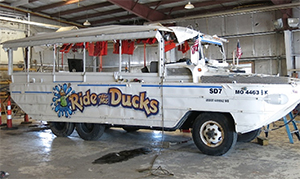Seventeen people died when a duck boat capsized and sank in Table Rock Lake near Branson, Mo., during an intense July storm, raising new questions about the safety of the amphibious excursion vessels.
Stretch Duck 7 had 29 passengers and two crew on board when it sank at about 1910 on July 19, a few hundred yards from shore. Eyewitness videos taken before the sinking show the vessel struggling to make way in strong winds, rain and churning waves.
Authorities have just begun what could be a lengthy investigation into the case. In early August, the U.S. Coast Guard announced plans for a Marine Board of Investigation to determine the cause and contributing factors, and the National Transportation Safety Board (NTSB) has launched a separate inquiry.
“One of the focuses of the investigation is to determine whether or not the operation, and this particular voyage, was conducted in accordance with the operational guidance and operational manual for Ride the Ducks,” Coast Guard Capt. Scott Stoermer said during a news conference shortly after the incident.
Duck boats like Stretch Duck 7 are required to have personal flotation devices on board for all passengers. “The decision to don those PFDs is an operational decision for the captain on board,” Stoermer said.
Ripley Entertainment subsidiary Ride the Ducks Branson operated Stretch Duck 7. In a prepared statement, Ripley said it was “deeply saddened by the tragic accident that occurred in Branson” and remains supportive of affected families.
Ripley spokeswoman Suzanne Smagala declined to comment further, citing the ongoing investigations. Ripley faces multiple lawsuits stemming from the accident.
The captain and driver boarded Stretch Duck 7 at about 1827 and passengers got on board soon afterward, according to the NTSB, which released details from the duck boat’s digital video recorder system. The craft entered the water at about 1855, shortly after the captain held a safety briefing that described the location of emergency exits and life jackets. He showed passengers how to put on a life jacket.
Table Rock Lake, a man-made water body on the White River near the Missouri-Arkansas border, was initially calm when the craft entered from a boat ramp. Within five minutes, however, winds picked up and whitecaps appeared on the lake. The duck boat’s bilge alarm sounded at about 1905, which the captain appeared to silence manually, according to the NTSB.
 |
|
Stretch Duck 7, shown in a post-accident photo, has forward-facing exhaust that a private inspector cited as a potential safety hazard in 2017. |
|
Courtesy NTSB |
The agency reported that water splashed into the passenger compartment during the final minutes of the recording. The bilge alarm sounded again at 1907, and the recording stopped a minute later while the craft was still afloat.
A video taken by a passenger on the nearby Showboat Branson Belle showed two duck boats moving slowly toward shore. One moved out of the frame, while Stretch Duck 7 sat lower and lower in the water while making little or no headway. The duck boat sank in about 15 feet of water near Showboat Branson Belle but came to rest at a depth of about 70 feet.
The storm that battered the Branson area that day was uncharacteristically strong. Coast Guard spokeswoman Lt. Amy Midgett said the duck boats encountered sustained 70-mph winds with gusts reaching 100 mph.
Salvage crews from Fitzco Marine Group raised Stretch Duck 7 four days after the sinking using a rig-sling system installed by Missouri State Highway Patrol divers. State authorities turned over the vessel to the NTSB after it was transferred onto land.
Duck boat tours that allow passengers to sightsee from land and water are popular across the United States. The amphibious vessels are either military-modified — U.S. Army landing craft that were originally deployed to carry troops and supplies during World War II — or are purpose-built as replicas like Stretch Duck 7. It’s a design that some critics say was never intended for continuous use.
Steve Paul of St. Louis-based Test Drive Technologies inspected Stretch Duck 7 in 2017 shortly before Ripley bought the operation and its 22 duck boats. He identified several design issues, including forward-facing exhaust and a hard-top canopy system that could hinder escape during emergencies.
“The exhaust was forward of the vessel … so if they are going through any type of wake or waves, they are going to take water into the exhaust system,” Paul said in a telephone interview.
Paul also said the engine controls the bilge system on the duck boats, so if the engine shuts down from taking on too much water, the bilge would fail as well.
His inspection was conducted to determine whether the vessels would need upgrades in the event that the Missouri Department of Transportation decided to regulate them. He included several of these issues in a report to Ripley, including a note that the exhaust should come out behind the passenger area.
 |
|
A memory card from the duck boat’s digital video recorder system revealed that the bilge alarm sounded twice before the vessel sank. |
|
Courtesy NTSB |
“Visually, it doesn’t look like they made any changes that I suggested,” Paul said.
There have been multiple fatal accidents involving duck boats over the years, including a 1999 accident on Lake Hamilton, near Hot Springs, Ark., that left 13 people dead. The vessel, Miss Majestic, took on water due to a component failure and rapidly sank stern first. The NTSB determined in a 2002 report that the lack of reserve buoyancy was the primary cause of the sinking. Insufficient Coast Guard oversight contributed to the accident, the agency said.
Jim Hall, the NTSB chairman during the Clinton administration, said virtually none of the agency’s safety recommendations stemming from the Miss Majestic incident were adopted. He now believes duck boats should be banned.
“To safely use this boat, you would need to have a very closely structured safety system with adequate oversight, and none of that has happened,” he said in a recent phone interview from his home in Tennessee. “The (duck boat) industry itself has failed, the associations that represent the industry have failed … and the Coast Guard has done little to nothing in terms of trying to ensure the safety of these vehicles.”
Hall added that the Coast Guard is limited by its funding and other factors.
The Coast Guard regulates duck boats under Subchapter T rules governing small passenger boats. It also issued inspection guidelines for Coast Guard personnel and amphibious vessels after the Miss Majestic incident.
On Aug. 1, following the Stretch Duck 7 incident, the Coast Guard issued a marine safety information bulletin urging operators to take immediate steps to improve operational safety on duck boats.
One recommendation called for “a proactive approach to vessel oversight to include frequent communications with the master for hazard monitoring, to include changes in weather conditions.”

